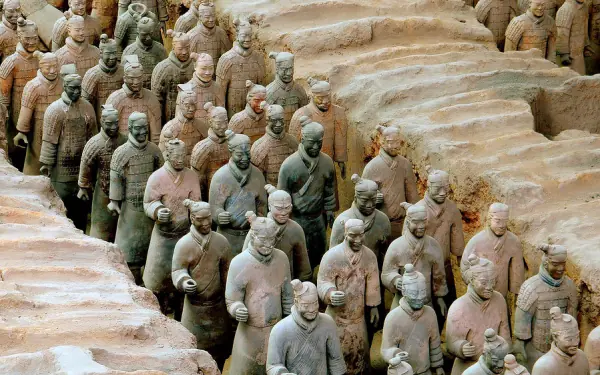
"The Astounding Citadel of Qin Shi Huang - The World's Most Amazing City-Crypt - Work To World"
Emperor Qin Shi Huang is one of the most odious figures in the history of ancient China. A bright example of his power is Qin Shi Huang’s tomb - the most fabulous mausoleum complex in the world.

The burial complex area of about 60 square kilometers is an entirely underground city, dug to a depth of 70 to 120 meters below the aquifers. With an area of 350x345 meters almost square in shape, it is oriented to the cardinal points. The center of the underground city is occupied by the emperor’s mausoleum with over 500 tombs of his courtiers and servants around it.
700,000 people a day were sweating at the tomb construction, which lasted more than 40 years. Given the fact that the construction of the underground city crypt dates back to the beginning of III century BC, we can imagine the tremendousness of this architectural project for that time.
Emperor Qin Shi Huang was known to become the ruler of the Qin Empire in the year 246 BC when he was only 13 years old. The ascent to the throne of the emperor's grandson by a low-ranking concubine became possible as a result of court intrigues of the powerful and cunning courtier Lü Buwei. According to the records of Chinese history, Qin Shi Huang became the first emperor to put an end to a centuries-old era of the Warring States Period, and to bend 6 neighboring kingdoms to his centralized power. This land consolidation continued from 230 to 221 BC. It was then that his name appeared with a flexion "di". "Huangdi" literally means "emperor-founder."
Upon the unification of the lands, Qin Shi Huang introduced a single currency, a unified measure of weights, and writing standards. It was he, whose ministry formed a bureaucratic structure, whose principles are still in effect in today’s China. The era of the Qin Shi Huang reign saw the erection of the Great Wall of China, which fenced China off nomads, the 36 km-long Lingqu Canal, to cover the empire’s vast areas by river transport, and a unified system of roads. At the same time, in parallel with them, the construction of the Shi Huang mausoleum complex was started at the foot of Li Mountain, 20 km away from modern Xian.
It is worth mentioning that, having ascended to the throne being still a child, Qin Shi Huang even at that time was dreaming of life everlasting. In search of immortality, he had traveled all over the empire and went outside looking for an answer from the local healers and monks. As a result, not having found pills of immortality, the Emperor was preparing to rule the next world after his death. Therefore, Qin Shi Huang attached such importance to the construction of the mausoleum. Everything in the mausoleum was to indicate the eternal life and the might of Qin Shi Huang.
The Qin Shi Huang’s tomb planning reminds us of the city of Xianyang - the capital of the Qin kingdom at that time. There also was an outer and inner city divided by a high wall. A huge mausoleum underground was reinforced with metal beams. Its center was occupied by an imperial residence hall. There stood a sarcophagus of pure gold, surrounded by rivers made with mercury. The ceiling was designed in the form of the sky, while the floor represented a map of the empire. The room was lit up with "ever-burning" lamps, and the untold wealth of the imperial treasury was brought together there. Above the sarcophagus, there was a pyramid-shaped structure so that the emperor’s soul could ascend to the sky. The pyramid was hidden by an artificial mound of thick loess soil.
The mausoleum was protected with many ingenious pitfalls that were sure to catch an occasional curious person or a robber. Upon completion of the mausoleum, hundreds of the emperor’s servants and servitors were buried alive to serve him also after his death.
Although Qin Shi Huang cherished the hope that his descendants would be ruling for another 10,000 years after his death, the empire existed only three years. It was broken up, dilacerated by civil strife unleashed by the descendants of the former rulers of conquered lands and peasant uprisings. But strange enough that none of them touched the tomb, and in the course of time, it sank into oblivion. A few centuries passed before the burial mound of Qin Shi Huang was at last discovered.
News in the same category


I stayed silent when my husband called me his “youthful mistake” in front of everyone and laughed. But when he woke up in the apartment and saw the message on the mirror… He froze in shock!

I won $50 million in the lottery. I ran with our little son to my husband’s office to give him the news. When I arrived, I heard intimate sounds from him… So then, I did something.

After my husband’s funeral, my son drove me to a remote road and said: ‘This is where you get off. The house and business are mine now.’

AT 3 AM, I ASKED MY CHILDREN TO TAKE ME TO THE HOSPITAL. I COULD BARELY STAND. THEY YAWNED AND SAID: ‘MOM, CALL AN UBER. WE HAVE WORK TOMORROW.’

I WENT TO THE HOSPITAL TO TAKE CARE OF MY HUSBAND WHO HAD A BROKEN BONE. WHILE HE WAS SLEEPING, THE HEAD NURSE SLIPPED A PIECE OF PAPER INTO MY HAND: “DON’T COME AGAIN. CHECK THE CAMERA…”

ON OUR 10TH YEAR ANNIVERSARY DINNER, I STOOD IN FRONT OF EVERYONE WITH A BLACK EYE. THE ROOM WENT SILENT. MY HUSBAND SAID PROUDLY ‘IT’S WAS MY SISTERS…

Baggage Handler Explains Why Tying a Ribbon on Your Luggage Is a Bad Idea

My husband hit me because I told him he often went out with his friends. Afterward, he calmly went to sleep. The next morning, he brought me some makeup and said, “My friends are coming over for lunch. Cover up these wounds and smile.”

Mom rubbed raw chili paste into my eyes for refusing to be my sister’s maid. She said now you see what pain looks like, so I made sure they cried every day…

I was eight months pregnant with twins when I hit the jackpot — $850,000.

Suddenly, my husband became very attentive and prepared a special breakfast for me because I had severe morning sickness.

After I gave birth, my wealthy father came to me and asked: “Honey, are the $4,000 a month not enough for you?”

When I left prison, I rushed to my father’s house, but my stepmother said coldly, “Your father was buried a year ago. We live here now.” .” Shaken, I went to the cemetery to find his grave.

The Person That Everyone Leans On—But No One Ever Checks On—Usually Displays These 9 Quiet Signs of Exhaustion

Psychologists Reveal 9 Activities Associated with High Cognitive Ability

What does it symbolize when a person who passed away appears in your dream

My Daughter’s Lookalike Neighbor Sparked Cheating Fears, But the Truth Was Worse

Two Teens Mock Poor Old Lady On Bus

Shocking: Savannah Miller, 24, Forgot Her Tampon Inside Her for a Month
News Post

Don’t Soak Frozen Meat in Cold Water: A Chef’s 5-Minute Thawing Trick That Keeps Meat Tasty and Nutritious

A Breakthrough in Glioblastoma Immunotherapy: Rapid Tumor Regression with CARv3-TEAM-E

Pomegranate Seed Oil Supplementation and Cognitive Improvement in Mild Cognitive Impairment

Selective Anti-Cancer Effects of Frankincense: Evidence from Laboratory Studies

Kimchi Consumption and Immune Balance: Evidence from a 12-Week Human Clinical Study

Selective Anti-Cancer Activity of Dandelion Root Extract in Colorectal Cancer

Inducing Lethal Autophagy in Glioblastoma Through Drug Repurposing

WHO Recommends GLP-1 Therapies for Obesity Management in Landmark New Guidance

mRNA Flu Vaccines Show Higher Effectiveness Than Traditional Quadrivalent Shots, Phase 3 Trial Finds

A cold draft keeps sneaking in under my front door, and the handyman can’t come until after the holidays. What can I do right now?

The 30-Minute Rule Everyone Needs to Know

These red patches flare up every night, but my doc can’t see me until next month. Any idea what’s happening?

Early Signs of Multiple Sclerosis

11 Benefits of Going Caffeine-Free

5 Early Signs of Cervical Cancer That Are Often Ignored: 90% of Women Overlook Them

The Cheap Drink That Can Help Prevent Stroke, Reduce Blood Fat, and Fight Cancer

Bone-chilling 2025 predictions from both Nostradamus and Baba Vanga

2 quick and easy ways to wash yellowed pillow inserts, making them sparkling white like new in no time

Yellowed, burnt-on stainless steel pots will shine like new after soaking them in this water
